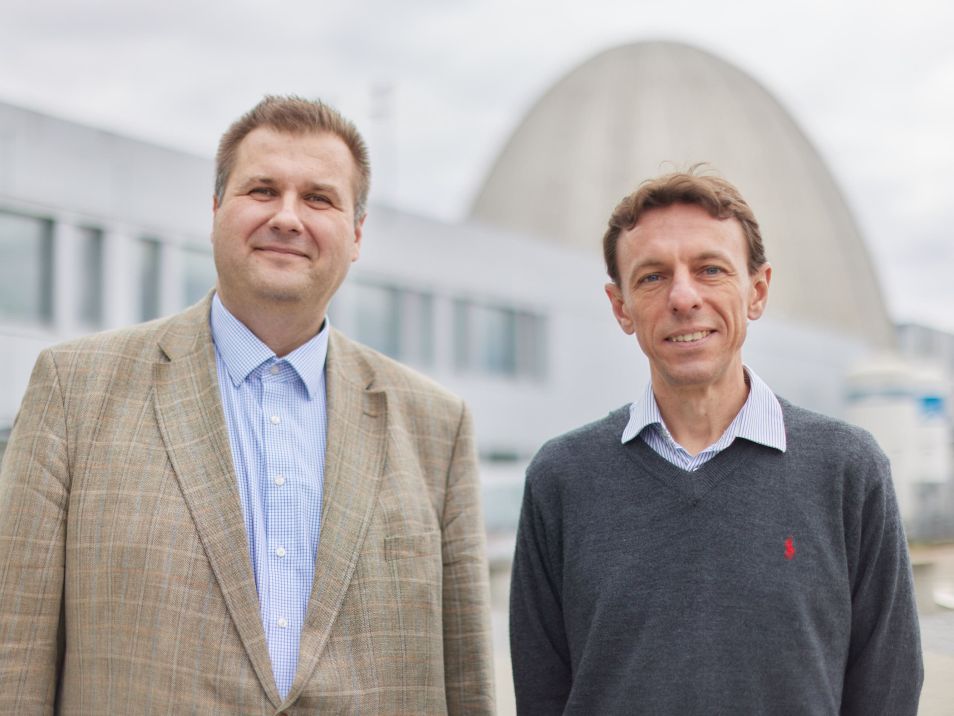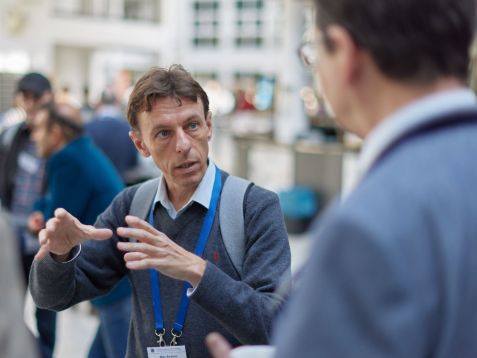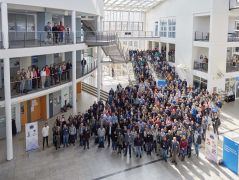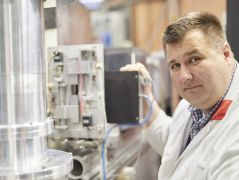MLZ is a cooperation between:
 > Technische Universität München
> Technische Universität München > Helmholtz-Zentrum Hereon
> Helmholtz-Zentrum Hereon
 > Forschungszentrum Jülich
> Forschungszentrum Jülich
MLZ is a member of:
 > LENS
> LENS > ERF-AISBL
> ERF-AISBL
MLZ on social media:

MLZ (eng)
Lichtenbergstr.1
85748 Garching
26.05.2023
From Sydney to Garching: Professor Maxim Avdeev at the MLZ
In March 2023 MLZ had the pleasure of hosting Maxim Avdeev – Diffraction Group Manager at the Australian Nuclear Science and Technology Organisation and professor at the University of Sydney. The MLZ Science Group “Structure Research” acted as Prof Avdeev’s local host.
“I’ve never done anything like this before, it’s kind of exciting!” says Prof. Dr. Maxim Avdeev as he poses for a photo during a break from the European Conference on Neutron Scattering (ECNS) 2023.
It took some time for him to finally travel from Sydney to Munich. Planning for the visit had begun before the Corona pandemic and had to be scrapped several times due to travel restrictions. It was made possible by the TUM Global Visiting Professor Program which offers the opportunity to recruit excellent professors from top universities for teaching and research collaborations.
Dr. Anatoliy Senyshyn is an instrument scientist at the SPODI high-resolution structural powder diffractometer, and it is at his suggestion, MLZ’s scientific director Peter Müller-Buschbaum invited Avdeev. They arranged for their guest to attend ECNS in Garching, give a presentation at TUM.Int, and to exchange ideas with PostDocs and Ph.D. students from MLZ and TUM.
From chemist to neutron researcher
Maxim Avdeev is actually a chemist with a focus on materials research. He earned his Ph.D. in physical chemistry in 1999 at the Southern Federal University in Rostov, Russia, followed by two postdocs in Portugal and at Argonne National Laboratory in the United States. In 2005, he joined the Australian Nuclear Science and Technology Organisation (ANSTO) as a research scientist and co-responsible for the Echidna neutron diffractometers, similar to SPODI. Since 2021, he also holds a professor position at the University of Sydney. Max Avdeev first came to neutron research as an external user, when doing research in crystal structure of inorganic materials for his Ph.D. Over the years, however, his interest in the methodology grew, so he specialized in it. He sees the fact that he is something of a career changer as a great advantage: “Science is becoming increasingly interdisciplinary and our problems more complex. Being able to take different perspectives is increasingly important.”
MLZ “very interesting for my students”
Like FRM II near Munich, the Open Pool Australian Lightwater Reactor (OPAL) is located not far from Sydney. That is where Senyshyn sent two of his doctoral students in January to conduct neutron scattering experiments with Avdeev. International collaboration in science makes it possible for young researchers to make their measurements with neutrons even during the current ongoing break in operations at FRM II. “Once FRM II is operational again, it would be very interesting for my students to visit Anatoly’s group,” Avdeev said.
Avdeev is particularly impressed by the MLZ’s close ties to TUM. “The formal connection makes it easier for young scientists to use neutrons or specialize in research with them.” He says the connection between ANSTO and Australian universities is less direct, although efforts are being made to intensify exchanges through workshops, for example.
“Strengthening the link between MLZ and ANSTO.”
Australia has about 26 million people in an area more than 20 times the size of Germany and is in a relatively remote area of the world. FRM II, on the other hand, has the advantage of having access to economies with 80 million people just in Germany and nearly 450 million in the European Union, based on its geographic location alone.
ANSTO’s long-term strategy, then, is to strengthen ties with international partners to foster exchanges of scientists and attract users for both academic and commercial use of neutrons.
Max Avdeev sees his visit to MLZ as an important step in this direction: “I think this trip was successful and we should continue to work on strengthening the links between MLZ and ANSTO. I am looking forward to stronger cooperation with colleagues from Garching.”
More Information:
TUM Global Visiting Professor Program
Australian Nuclear Science and Technology Organisation
Related News
-
03.04.2023
More than 500 researchers at conference at MLZ
From March 20th to 23rd, the eighth European Conference on Neutron Scattering (ECNS) took place in Garching. After St. Petersburg (2019) and Zaragoza (2015), the Heinz Maier-Leibnitz Zentrum was this year’s host. Read more -
14.02.2023
Solid-state battery: New material class with excellent ion conductivity
A research team at the Technical University of Munich (TUM) has discovered a material class with above-average conductivity. This is a decisive step forward in the development of high-performance solid-state batteries. Investigations conducted at the Research Neutron Source Heinz Maier-Leibnitz (FRM II) made an essential contribution to the discovery. Read more
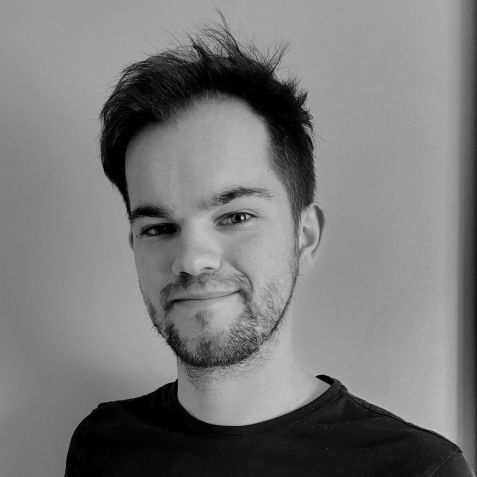
Adrian Büchl
Press and public relations FRM II
MLZ is a cooperation between:
 > Technische Universität München
> Technische Universität München > Helmholtz-Zentrum Hereon
> Helmholtz-Zentrum Hereon
 > Forschungszentrum Jülich
> Forschungszentrum Jülich
MLZ is a member of:
 > LENS
> LENS > ERF-AISBL
> ERF-AISBL
MLZ on social media:




